Thoroughly analyzing AP Inter 1st Year Physics Model Papers and AP Inter 1st Year Physics Question Paper May 2018 helps students identify their strengths and weaknesses.
AP Inter 1st Year Physics Question Paper May 2018
Time: 3 Hours
Maximum Marks: 60
Section – A (10 × 2 = 20)
Note :
- Answer ALL questions.
- Each question carries TWO marks.
- ALL are Very Short Answer Type Questions.
Question 1.
What is the discovery of C.V Raman ?
Answer:
In elastic scattering of light by molecules. This is called Raman effect.
Question 2.
The percentage error in the mass and speed are 2% and 3% respectively. What is the maximum percentage error in kinetic energy ?
Answer:
\(\frac{\Delta \mathrm{M}}{\mathrm{M}}\) × 100 = 2%, \(\frac{\Delta \mathrm{V}}{\mathrm{V}}\) × 100 = 3%
Kinetic energy = \(\frac{1}{2}\)mV2
\(\frac{\Delta \mathrm{K}}{\mathrm{K}}\) × 100 = \(\frac{\Delta \mathrm{M}}{\mathrm{M}}\) × 100 + 2\(\frac{\Delta \mathrm{V}}{\mathrm{V}}\) × 100
= 2 + 2(3) = 2 + 6 = 8%.
Question 3.
When two right-angled vectors of magnitude 7 units and 24 units combine, what is the magnitude of their resultant ?
Answer:
θ = 90°
P = 7 units
Q = 24 units
R= \(\sqrt{\mathrm{P}^2+\mathrm{Q}^2+2 \mathrm{PQ} \cos \theta}\)
= \(\sqrt{7^2+24^2+2 \times 7 \times 24 \times \cos 90^{\circ}}\)
= \(\sqrt{49+576}\)
= \(\sqrt{625}\) = 25 units.
![]()
Question 4.
According to Newton’s third law, every force is accompanied by an equal and opposite force. How can a movement ever take place ?
Answer:
Because both action and reaction are taking place on different bodies.
Question 5.
What is magnus effect ?
Answer:
The difference in the velocities of air results in the pressure difference between the lower and upper faces and there is a net upward force on the ball. This dynamic lift due to spin¬ning is called magnus effect.
Question 6.
Why are drops and bubbles spherical ?
Answer:
The surface tension of a liquid tends to have minimum surface area. For a given volume, the surface area is minimum for a sphere. Hence rain drops are spherical shape.
Question 7.
State Newton’s law of cooling;,
Answer:
The rate of loss of heat is directly proportional to the difference in temperature between the body and its surrounding provided the temperature difference is small.
i.e., \(\frac{\mathrm{dQ}}{\mathrm{dt}}\) ∝ (T – Ts)
Question 8.
Why are utensils coated black ? Why are the bottom of the utensils made of copper ?
Answer:
- Utensils are coated black, because it is a good absorber of heat.
- Copper is a good conductor of heat. So, copper is used at the bottom of cooking utensils.
Question 9.
Define mean free path.
Answer:
The average distance covered by a molecule between two successive collisions is called the mean free path.
Question 10.
What is the expression between pressure and kinetic energy of a gas molecule ?
Answer:
By kinetic theory pressure, P = \(\frac{1}{3} \mathrm{~m} \overline{\mathrm{V}}^2\) and kinetic energy.
= \(\frac{1}{2} \mathrm{~m} \overline{\mathrm{V}}^2\) where m is the mass of the molecules, n is the number of moles per unit volume, V is the mean-square-speed.
∴ P = \(\frac{1}{2}\)(\(\frac{1}{2} \mathrm{~m} \overline{\mathrm{V}}^2\)) = \(\frac{2}{3}\)(kinetic energy)
![]()
Section – B (6 × 4 = 24)
Note :
- Answer any SIX of the following questions.
- Each question carries FOUR marks.
- ALL are Short Answer Type Questions.
Question 11.
A man walks on a straight road from his home to a market 2.5 km away with a speed of 5 kmh-1. Finding the market closed, he instantly turns and walks back home with a speed of 7.5 kmh-1. What is the (a) magnitude of average velocity and (b) average speed of the man over the time interval 0 to 50 minutes ?
Answer:

Question 12.
Show that the trajectory of an object thrown at certain angle with horizontal is a parabola.
Answer:
Consider a body is projected with an initial velocity (u) making an angle θ with the horizontal. The body does not experience acceleration in horizontal direction.
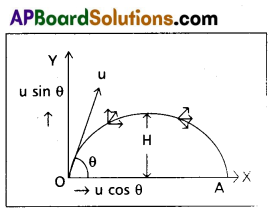
The velocity of the projectile can be resolved into (i) u cos θ, horizontal component (ii) u sin θ, vertical component. The horizontal component of velocity remains constant through out the motion. Only its vertical component changes due to acceleration due to gravity (g).
The distance travelled along OX in time t is given by
x = u cos θ × t ; t = \(\frac{\mathrm{x}}{\mathrm{u} \cos \theta}\) ……. (1)
The distance travelled along by in time t is given by
y = (u cos θ) t \(\frac{1}{2}\) gt2 ……… (2)
Substituting eq. (1) in eq. (2)
y = (u sin θ) \(\frac{\mathrm{x}}{\mathrm{u} \cos \theta}\) – \(\frac{1}{2}\) g (\(\frac{x^2}{u^2 \cos ^2 \theta}\)) [∵ u = u sin θ, a = -g, s = y]
y = x tan θ – (\(\frac{g}{2 u^2 \cos ^2 \theta}\)) x2
Let A = tan θ and B = \(\frac{g}{2 u^2 \cos ^2 \theta}\)
Y = Ax – Bx2
Where A and B are constants.
This is the equation of parabola.
∴ The trajectory of a projectile is parabola.
Question 13.
Explain the methods used to decrease friction.
Answer:
- Polishing : By polishing the surfaces of contact, friction can be reduced.
- Bearings : The rolling friction is less than the sliding friction hence free wheels of a cycle, motor car, dynamos etc., are provided with ball bearings to reduce friction. Bearings convert sliding motion into rolling motion.
- Lubricants : The lubricant forms a thin layer between surfaces of contact. It reduces the friction. In light vehicles or machines, oils like “three in one” are used as lubricants. In heavy machines greasure is used. In addition to this they guard the’mechanical parts from over heating.
- Streamlining : Automobiles and aeroplanes are streamlined to reduce the friction due to air.
Question 14.
Show that a system of particles moving under the influence of an external force, moves as if the force is applied at its centre of mass.
Answer:
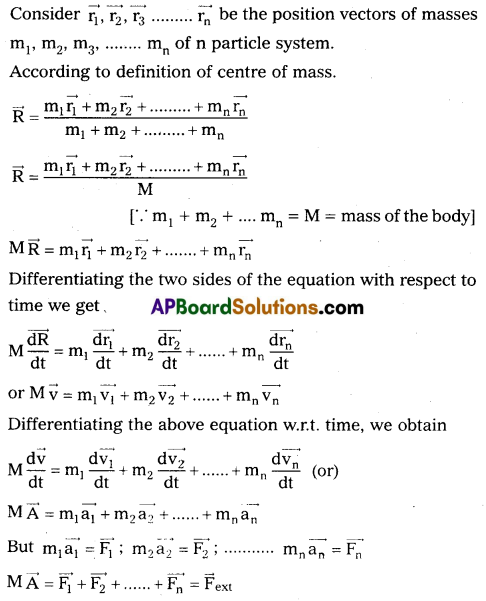
Where Fext represents the sum of all external forces acting on the particles of the system.
This equation states that the centre of mass of a system of particles moves as if all the mass of the system was concentrated at the centre of mass and all the external forces were applied at that point.
![]()
Question 15.
Define vector product. Explain the properties of a vector product with two examples.
Answer:
The cross product of two vectors is given by \(\vec{C}\) = \(\vec{A}\) × \(\vec{B}\) . The magnitude of the vector defined from cross product of two vectors is equal to product of magnitudes of the vectors and sine of angle between the vectors.
Direction of the vectors is given by right hand corkscrew rule and is perpendicular to the plane containing the vectors.
∴ | \(\vec{C}\) | = AB sin θ. and \(\vec{C}\) = AB sin θ n̂.
When, n̂ is the unit vector perpendicular to the plane containing the vectors \(\vec{A}\) and \(\vec{B}\)
Example :
1) Torque is cross product of position vector and Force.
i.e., \(\vec{T}\) = \(\vec{r}\) × \(\vec{F}\)
2) Angular momentum is cross product of position vector and momentum
i.e., \(\vec{L}\) = \(\vec{r}\) × \(\vec{P}\)
Properties :
1) Cross product does not obey commutative law. But its magnitude obey’s commutative law.
\(\vec{A}\) × \(\vec{B}\) ≠ \(\vec{B}\) × \(\vec{A}\) = – (\(\vec{B}\) × \(\vec{A}\)) , |(\(\vec{A}\) × \(\vec{B}\))| = |(\(\vec{B}\) × \(\vec{A}\))|
2) It obeys distributive law \(\vec{A}\) × (\(\vec{B}\) × \(\vec{C}\)) = \(\vec{A}\) × \(\vec{B}\) + \(\vec{A}\) × \(\vec{C}\)
3) The magnitude of cross product of two vectors which are parallel is zero. Since θ = 0; | \(\vec{A}\) × \(\vec{B}\) | = AB sin 0° = 0
4) For perpendicular vectors, θ = 90°, | \(\vec{A}\) × \(\vec{B}\) | = AB sin 90° | n̂ | = AB
Question 16.
What is orbital velocity ? Obtain an expression for it.
Answer:
Orbital velocity (V0) : The horizontal velocity required for an object to revolve around a planet in a circular orbit is called orbital velocity.
Expression for orbital velocity : Consider a body (satellite) of mass m, revolves round the earth in a circular orbit. Let h be the height of the satellite from the surface of the earth. Then (R + h) is the radius of the orbit.
The Gravitational force of attraction of the earth on the body is given by F = \(\frac{\mathrm{GMm}}{(\mathrm{R}+\mathrm{h})^2}\) …… (1)
Where, M = Mass of the earth, R = Radius of the earth, G = universal gravitational constant.
If V0 is the orbital velocity of the body.
The centripetal force on the body is given by F = \(\frac{\mathrm{mv}_0^2}{(\mathrm{R}+\mathrm{h})}\) …… (2)
In order to make the body revolve in the same orbit, its centripetal force must be equal to the gravitational force From eq’s (1) and (2),
\(\frac{\mathrm{GMm}}{(\mathrm{R}+\mathrm{h})^2}\) = \(\frac{\mathrm{mv}_0^2}{(\mathrm{R}+\mathrm{h})}\)
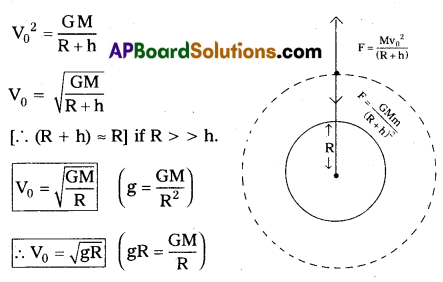
Question 17.
Explain the concept of elastic potential energy in a stretched wire and hence obtain the expression for it.
Answer:
The potential energy stored in a body when stretched is called strain energy.
Let us consider a wire of length L and cross-sectional area A. Let x be the change in length of the wire by the application of stretching force F.
Young’s modulus = \(\frac{\text { Longitudinal Stress }}{\text { Longitudinal Strain }}\)
y = \(\frac{\mathrm{FL}}{\mathrm{Ax}}\)
F= \(\frac{\mathrm{yAx}}{\mathrm{L}}\) ………. (1)
To stretch the wire further by dx, the workdone
dw = F.dx
dw = (\(\frac{\mathrm{yAx}}{\mathrm{L}}\)) dx
Total work done to stretch the wire from O to x is given by

w = \(\frac{1}{2}\)F.x = \(\frac{1}{2}\) × stretching force × elongation
The work done is stored in the form of potential energy.
u = \(\frac{1}{2}\)F.x ……….. (2)
Strain energy per unit volume = \(\frac{1}{2}\) × \(\frac{F x}{A L}\)
= \(\frac{1}{2}\) × Stress × Strain
![]()
Question 18.
In what way is the anomalous behaviour of water advantageous to aquatic animals ?
Answer:
In cold countries, as atmospheric temperature decreases, the upper layer of the lakes, rivers etc., cool, contract and sink to the bottom (fig). This goes on until the whole of the water reaches the temperature of 4°C. When the top layers cool further temperature falls below 4°C, it expands and becomes lighter. It does not sink downwards and remains at the top. With further cooling the top layer gradually form ice at the top (fig). Ice and water are bad conductors of heat. So the lower layers are protected against freezing by the layers of ice and cold water at 1°C, 2°C and 3°C. This results in water remaining at the bottom at 4°C. So that aquatic animals survive in those layers of water.
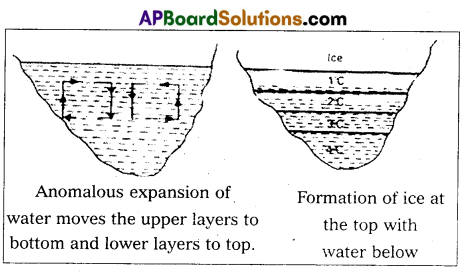
Section – C (2 × 8 = 16)
Note :
- Answer any TWO of the following questions.
- Each question carries EIGHT marks.
- ALL are Long Answer Type Questions.
Question 19.
State and prove law of conservation of energy in case of a freely falling body. A pump is required to lift 600 kg of water per minute from a well 25 m deep and to eject it with a speed of 50 ms-1. Calculate the power required to perform the above task ?
Answer:
Statement : “Energy can be neither created nor destroyed but it can be converted from one form to another form, (or) The total energy of a closed system always remains constant” is called law of conservation of energy.
Proof : In case of freely falling body : A body of mass ‘m’ is dropped or freely falling at a height ‘H’ from the ground. The total mechanical energy of the body E = K + U.
Where K = Kinetic Energy; U = Potential energy.
Suppose A, B and C are the points as heights H, h and ground respectively.

At ‘A’ : At the highest point, velocity u = 0
Kinetic energy K.E. = \(\frac{1}{2}\) mu2 = 0
Potential energy PE. = mgH
Total mechanical energy of the body
= EA = P.E. + K.E.
= mgH + 0
∴ EA = mgH ………… (1)
At ‘B’ : When the body falls from A to B, which is at a height ‘h’ from the ground. The velocity of the body at ‘B’ is VB.
At ‘B’ the body possess both P.E. and K.E.
S = H – h
u = 0
a = g
V = VB = ?
VB2 – U2 = 2as
a = g VB2 – 0 = 2g(H – h)
v = VB = ? VB = 2g(H – h)
Kinetic energy of the body (K) = \(\frac{1}{2} \mathrm{mv}_{\mathrm{B}}^2\) = \(\frac{1}{2}\) m 2g(H – h)
K = mg(H – h)
Potential energy (u) = mgh
Total mechanical energy at B = K + u
EB = mg(H – h) + mgH
EB = mgh ………… (2)
At ‘C’ : When the body reaches the point ‘C’ on the ground. The velocity of the body at ‘C’ is ‘V’ can be found by using v2 – u2 = 2as equation.
S = H \(\mathrm{V}_{\mathrm{C}}^2\) – 0 = 2gH
u = 0 \(\mathrm{V}_{\mathrm{C}}^2\) = 2gH
a = g VC = \(\sqrt{2 \mathrm{gH}}\)
v = vc = ?
Kinetic energy of the body (K) = \(\frac{1}{2} m v_c^2\)
= \(\frac{1}{2}\) m 2gH = mgH
Potential energy (u) = 0
Total energy at c = k + u
Ec = mgH ……….. (3)
From the above three equations (1), (2) and (3) the mechani¬cal energy of the body remains constant under the action of gravitational force. Hence, law of conservation of energy is proved incase of freely falling body.
Problem :
m = 600 kg
t = 1 min = 60 sec
h = 25 m
V = 50 m/s
P = \(\frac{W}{t}=\frac{m g h+\frac{1}{2} \mathrm{mv}^2}{t}\)
= \(\frac{600\left[10 \times 25+\frac{1}{2}(50)^2\right]}{60}\)
= 10 [250 + 1250]
P = 15,000 Watts.
Question 20.
Show that the motion of a simple pendulum is simple harmonic and hence derive an equation for its tiihe period. What is the length of a simple pendulum which ticks seconds ?
Answer:
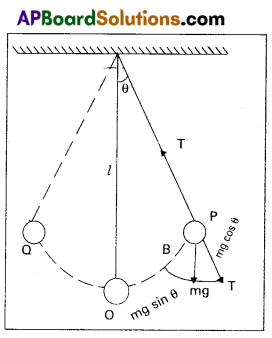
i) Consider simple pendulum, a small bob of mass m tied to an in – extensible mass less string of length L and other end of the string is fixed from a rigid support.
ii) Once the bob is slightly displaced and released, it begins to oscillate about mean position.
iii) Let θ be the angular displacement and T be the tension in the string.
iv) The forces acting on the bob are
(a) tension T along the string
(b) weight mg acts vertically downwards.
v) The force mg can be resolved into two components
- mg cos θ along the PA and
- mg sin θ acts along PB.
vi) From figure at point P, T = mg cos θ ……….. (1)
vii) The force mg sin θ will provide the restoring torque, which tends to bring the bob back to its mean position O.
viii) The restoring torque is given by
τ = Restoring force × ⊥lar distance
τ = -mg sin θ × L ………. (2)
Here negative sign shows that the torque acts to reduce θ.
Then sin θ is replaced by θ i.e., sin θ = θ τ = -mg L θ …………. (3)
(∵ sin θ = θ – \(\frac{\theta^3}{3 !}\) + \(\frac{\theta^5}{5 !}\) …… )
ix) From equation (3), we note that τ ∝ θ and This τ will bring the bob back towards its equilibrium position.
So, if the bob is left free, it will execute angular simple harmonic motion.
Comparing equation (3), with the equation τ = -kθ, we have Spring factor, k = mgL.
x) Here inertia factor = Moment of inertia of the bob about the point of suspension = mL2
xi) In S.H.M, Time period (T) = \(2 \pi \sqrt{\frac{\text { Inertia factor }}{\text { Spring factor }}}\)
T = \(2 \pi \sqrt{\frac{\mathrm{mL}^2}{\mathrm{mgL}}}\)
T = \(2 \pi \sqrt{\frac{L}{g}}\) ………… (4)
Seconds pendulum : A pendulum whose time period is 2 seconds is called seconds pendulum.
T = 2 seconds.
![]()
Question 21.
Explain reversible and irreversible processes. Describe the working of a Carnot engine. Obtain an expression for the efficiency.
Answer:
Reversible process : A process that can be retraced back in the opposite direction in such away that the system passes through the same states as in the direct process, and finally the system and the surroundings return in their original states, is called a reversible process.
A reversible process is only a purely idealised process.
Examples :
- Slow isothermal and slow adiabatic changes.
- Peltier effect and seeback effect.
- Fusion of ice and vaporisation of water.
Irreversible process: “A process that cannot be retraced back in the opposite direction” is called as irreversible process.
In this process the system does not pass through the same intermediate states as in the reversible process.
All natural processes such as conduction, radiation, radioactivity etc, are irreversible.
Example :
- Work done against friction.
- Heat produced in conductors by passing a current through it. (Joule heating)
- Diffusion of gases.
Carnot Engine : A reversible heat engine operating between two temperatures is called a camot engine. The cycle operating it is known as camot’s cycle. In this cycle the working sub¬stance (say an ideal gas) is taken through a cycle by means of two isothermals and two adiabatics. The four operations are shown in P-V (Indicator) diagram.
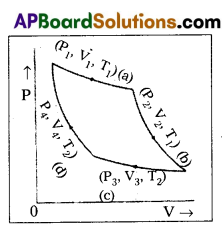
Step 1 → 2 : Isothermal expansion of the gas taking its state from (P1, V1, T1) to (P2, V2, T). It is shown in curve (a).
The heat absorbed by the gas (Q1) from the reservoir at temperature T1 equals the workdone by the gas. i.e.
W1 → 2 = Q1 = μRT1 loge \(\frac{V_2}{V_1}\) ……. (1)
Step 2 → 3 : Adiabatic expansion of the gas from (P2, V2, T1) to (P3, V3, T2). It is shown in curve (b). The work done by the gas is given by
W2 → 3 = \(\frac{\mu R\left(T_1-T_2\right)}{(r-1)}\)
Step 3 → 4 : Isothermal compression of the gas from (P3, V3, T2) to (P4, V4, T2). It is shown in curve (c).
Heat released (Q2) by the gas to the reservoir at temperature T2 equals the work done on the gas.
W3 → 4 = μRT2 loge\(\frac{V_4}{V_3}\) = – μRT2 loge\(\frac{V_3}{V_4}\)
Step 4 → 1 : Adiabatic compression of the gas from (P4, V4, T2) to (P1, V1, T1). It is shown incurve (d).
W4 → 1 = μR \(\frac{\left(T_2-T_1\right)}{(r-1)}\) = – μR \(\frac{\left(T_1-T_2\right)}{(r-1)}\)
Total workdone by the gas in one complete cycle is
W = W1 → 2 + W2 → 3 + W3 → 4 + W4 → 1
